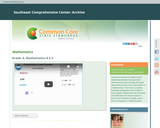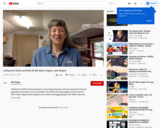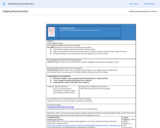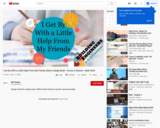
Using the robot, Dash, students will program him to land on different numbers in order to make a specific total.
- Subject:
- Mathematics
- STEM
- Material Type:
- Activity/Lab
- Author:
- Glenn Shelton
- Carrie Robledo
- Date Added:
- 03/30/2020

Using the robot, Dash, students will program him to land on different numbers in order to make a specific total.

As students are reviewing odd and even numbers, students first sketch out a bug that has odd or even features. Students then use Tinkercad to turn their sketch into a 3D design to be printed.

The class won a good behavior contest and the reward is a bowling party. The day of the party it is raining and the students are unable to visit the bowling alley. So the students build their own bowling alley using the WeDo robot kit. Then they have a bowling competition to see who bowls the highest score.

Students will use engineering materials to create a topographic map then program Sphero to be a tour guide through the map.

Design and build a sleigh using a WeDo kit, K’nex or similar, that will pull a specific measured weight.

As students study electricity and circuits, they can build their Operation games. Made from a few household materials, a makey-makey kit and the Scratch website, students can create and play their Operation game.

Students will create a fictitious city that has experienced a natural disaster. Once their city is completed, students will create a vehicle to transport supplies to the people who need help.

Students will be given a Makey Makey kit, a Chromebook with the Scratch website and a choice of materials to create a circuit that will allow the students to play an in instrument.

As students study the human body, they can include the different body systems as they build their Operation games. Made from a few household materials, a makey-makey kit and the Scratch website, students can create and play their Operation game.

Each team has a budget of $45 to spend to modify a cup into the ultimate predator. After predators are constructed, students battle to pop each others’ balloons. Whichever predator is able to survive is the apex predator.

The Common Core State Standards (CCSS) videos are designed to support states, schools, and teachers in the implementation of selected math standards. Each video is an audiovisual resource that focuses on one or more specific standards through examples and illustrations geared to enhancing understanding. The intent of each content-focused video is to clarify the meaning of the individual standard rather than to be a guide on how to teach each standard, although the examples can be adapted for instructional use.

Solve a series of arithmetic sequences in this Millionaire Maker game.

Students will design a device using Spheros or Sphero Minis and recyclables to help clean trash out of waterways.

Children love LEGOs! And knowing how to code is becoming more and more essential for the next generation of innovators, do-ers and leaders. Put LEGOs and coding together and you have the FIRST LEGO League Explore program, an innovative and engaging project that makes classroom learning popular and fun. We will demonstrate how to build and code with the LEGO WeDo 2.0 kit. In addition, we will learn more about how this kit is used in the FLL Explore program while walking-through the curriculum and the engineering notebook used by students in grades K-4. We will also share best practices for safe use of shared materials.

After brainstorming a list of essential businesses and/or points of interest, each student will create a building from recycled cardboard. They will then decide a location to house the building in the city. There will also be waterways included. Then in teams of 2-3 the students will use recycled materials to build a bridge to carry the ozobot through the city giving tours of important locations. The ozobot will need to be able to cross the bridge which will allow students to work through issues with force and motion.

Students are tasked with moving a 20 gram (or other low denomination) weight a distance of one meter using a “Sphero*” remote controlled robot. Students use available materials to design and build a structure that will allow the sphero to push or pull the weight, while allowing for factors such as friction, direction, and gravity. *Note: Although students can issue specific commands in the Sphero software, this activity only requires that they be able to “drive” the Sphero, thus providing the force to move the weight.

Students will create a graph based on data they have collected using Google Forms.

In this lesson students work in collaborative groups to collect, represent, and interpret numerical data that they generate by using Sphero robots to knock down bowling pins!

During this unit, students will learn about the Great Pacific Garbage Patch. They will read about the GPGP and then prepare a presentation with their findings and solutions. Lastly, they will create a prototype to help with the ocean cleanup and use Spheros to maneuver the prototype to pick up trash in water.

Design and build a sleigh using a WeDo kit that will pull a specific measured weight.